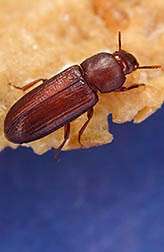April 30, 2009 weblog
Playing Dead Increases Survival Rate at the Expense of Active Neighbors

A study published in the Proceeding of The Royal Society B entitled "Tonically Immobilized Selfish Prey Can Survive By Sacrificing Other", authored by researchers at Okayama University in Japan point out death feigning has broad application among animal species.
The study involved the red flour beetle an its predator the jumping spider. The idea of playing dead to avoid confrontation with a powerful combatant has been observed in vertebrate and invertebrate animal species. The technical term to describe the behavior is tonic immobility or death-feigning. The Okayama University team comprised of environmental scientist, agricultural scientists and natural scientists, headed by Takahisa Miyatake et.al examined the following five hypotheses in the study:
Death feigning is effective for prey because, i) avoiding dead prey is safer for predators; ii) immobility plays a role in self defense; iii) immobility plays a role in concealment and/or background matching; iv) predators lose interest in non-moving prey; v) the characteristic immobilization posture signals a bad taste to predators.
For the purposes of the study at hand, researchers eliminated the "bad taste to predators" fifth hypothesis by introducing a chemical analysis of the secretions of the red flour beetle while under attack by the jumping spider. Particular attention was paid to the concept of "selfish-prey" which is the idea of feigning death or blending into the environment that acts to turn the predator's attention to moving prey. As an anti-predator strategy, death feigning or tonic immobility is very effective, but costly to more active neighbors.
The Okayama University team concluded that the death feigner's' survival rate increases in the presence of active prey or prey of a different species when compared to the sole feigner. Thus, the "selfish-prey" theory explains why immobility following an initial attack by the jumping spider increased the red flour beetles survival rate when active prey is present to engage the interest of the predator.
Sources:
• Proceedings of the Royal Society B, Tonically immobilized selfish prey can survive by sacrificing others, Takahisa Miyataka, Satoshi Nakayama, Yusuke Nishi, and Shuhei Nakajima, published, April 29, 2009.
• Is Death Feigning Adaptive? Heritable variation in fitness differences of death-feigning behaviour, Miyatake et.al, 2004, www.pubmedcentral.nih.gov/picr … 1691851&blobtype=pdf
© 2009 PhysOrg.com

















